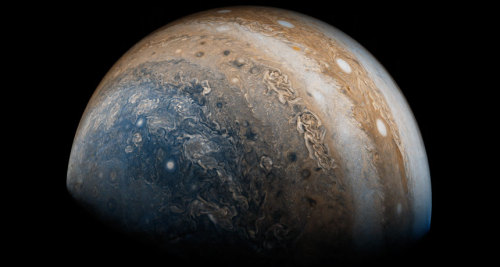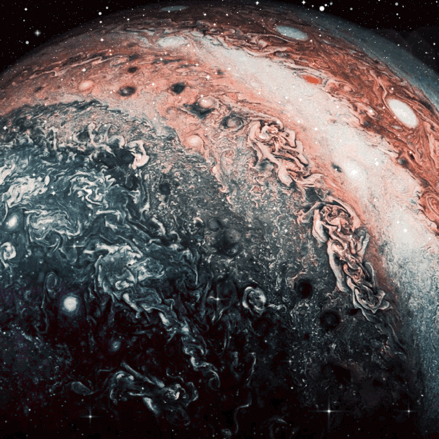Jupiter Descending










Jupiter Descending
More Posts from Jovian-witch and Others





Jupiter
Credits: NASA, ESA, JPL, Voyager 1, Hubble.
![Voyager 1 Approaching Jupiter In 1979. [Reddit/spacegifs]](https://64.media.tumblr.com/57003d3715c75582218ee1b20aeb6a70/tumblr_p21webfuy81s04h2ho1_400.gif)
Voyager 1 approaching Jupiter in 1979. [Reddit/spacegifs]
“Jupiter, you were larger than life, unfathomable to my small-town sensibilities. My heart couldn’t comprehend all of you at once. But this wasn’t my first rodeo; life had hurled love at me before. Step one of my plan: play hard to get. But, fuck, you called me and I came flying like an asteroid. So I chucked plans and lists out the window for you, threw my heart into your hands. Good thing you’re a good catch as well as a catch. Spontaneous lover, you danced and made up the steps as you went along. We kissed like giggling teenagers, we gossiped like cackling old women. You taught me rap songs, you took me to playgrounds at midnight so I could look at the star streaked sky while you pushed the swing higher and higher, until I was floating, until I felt as infinite as you. You kissed me until I tasted lightning.”
— the nine people i have loved as planets: jupiter // L.H.




Jupiter ✨ gifs made by me :)
cosmic witchcraft 101: jovian magick ♃
Jupiter is the fifth planet from the Sun. Due to its massive size, there are multiple ways the planet could have formed. Regardless of its formation process, some scientists believe that Jupiter migrated inward right up to the orbit of Mars after its initial formation. This is referred to as the Grand Tack Hypothesis. In the early solar system, Neptune and the other outer planets may have begun interacting with icy planetesimals, sending comets from one planet to the next, causing Uranus, Neptune, and Saturn to move outwards as the comets moved inwards. When the comets reached Jupiter, the planet’s massive gravity flung the comets into highly elliptical orbits or out of the solar system entirely and Jupiter migrated inwards to conserve angular momentum.
As it made its way towards the Sun, Jupiter’s gravity would have prevented the asteroid belt material from forming into planets and swept away large amounts of material that may have made Mars more massive. Thanks to Saturn, Jupiter stopped its inward migration and turned around, settling approximately where we see it today. As Jupiter moved inward and Saturn moved outward, it’s theorized that they became locked in a 3:2 orbital resonance, with Saturn finishing 3 orbits around the Sun for Jupiter’s 2. Jupiter’s migration may have also brought icy and gaseous material into the inner solar system, helping the inner planets form their atmospheres and perhaps even providing those vital life-giving compounds we can thank for our existence today.
Facts:
Jupiter produces more heat than it receives from the Sun.
Jupiter is more than twice as massive as all the other planets combined.
The planet has at least 67 moons.
Jupiter is NOT a failed star. The smallest stars in the observable universe have about 1/12 of the Sun’s mass, and Jupiter has about 1/1000th of the Sun’s mass. Jupiter is simply a colossal planet.
The Great Red Spot is larger than Earth. It’s a colossal hurricane that’s been going on since the 17th century, maybe even before that.
Jupiter rotates faster than any of the other planets; a Jovian day is only about 10 Earth hours. It takes 11.86 years to orbit around the Sun.
Lighter stripes along the planet are called zones and darker stripes are called belts. They flow in opposite directions and turbulence between regions causes the Jupiter’s storms.
Magickal Correspondences*
Colors: red, white, yellow, brown, purple
Intents: growth, expansion, prosperity, justice, exploration, freedom, protection, spiritual evolution, success, meditation, psychic development, confidence, storm magick
Herbs: frankincense, rosemary, oak, cedar, nutmeg, sage, anise, catnip, sandalwood, rosehips, dandelion, fennel, tansy
Crystals: tin, amethyst, lepidolite, sugilite, lapis lazuli, sapphire, diamond, agate, antimony, rhodocrosite, aragonite, jasper, onyx, amber
*some of these correspondences are based on traditional associations and some are based on my personal associations


Archetype Inspirations | Jupiter Witch


Archetype Inspirations | Jupiter Witch




Jupiter’s Big Red

Voyager 1 Jupiter
Ian Regan
-
 littlegr33nstore liked this · 1 month ago
littlegr33nstore liked this · 1 month ago -
 truthandshadow reblogged this · 1 month ago
truthandshadow reblogged this · 1 month ago -
 the-abyss-inn liked this · 1 month ago
the-abyss-inn liked this · 1 month ago -
 ketsler reblogged this · 2 months ago
ketsler reblogged this · 2 months ago -
 catoptriclunarian reblogged this · 3 months ago
catoptriclunarian reblogged this · 3 months ago -
 cometsofdoom liked this · 5 months ago
cometsofdoom liked this · 5 months ago -
 noelficken reblogged this · 5 months ago
noelficken reblogged this · 5 months ago -
 poynter66 liked this · 6 months ago
poynter66 liked this · 6 months ago -
 shuffle776 liked this · 6 months ago
shuffle776 liked this · 6 months ago -
 annita89nkd59vm0h liked this · 6 months ago
annita89nkd59vm0h liked this · 6 months ago -
 the-turbatron liked this · 8 months ago
the-turbatron liked this · 8 months ago -
 angryblondewithajetblackheart liked this · 8 months ago
angryblondewithajetblackheart liked this · 8 months ago -
 omgherbalicious liked this · 10 months ago
omgherbalicious liked this · 10 months ago -
 rockerosportsporn liked this · 10 months ago
rockerosportsporn liked this · 10 months ago -
 dieabadass reblogged this · 10 months ago
dieabadass reblogged this · 10 months ago -
 qreyjoytheon reblogged this · 10 months ago
qreyjoytheon reblogged this · 10 months ago -
 sub4t0m1c reblogged this · 11 months ago
sub4t0m1c reblogged this · 11 months ago -
 febrerodel2000 reblogged this · 11 months ago
febrerodel2000 reblogged this · 11 months ago -
 spofurydefendor552 liked this · 11 months ago
spofurydefendor552 liked this · 11 months ago -
 sub4t0m1c liked this · 11 months ago
sub4t0m1c liked this · 11 months ago -
 zomb-eh liked this · 1 year ago
zomb-eh liked this · 1 year ago -
 milkshakespear3 reblogged this · 1 year ago
milkshakespear3 reblogged this · 1 year ago -
 anathenma reblogged this · 1 year ago
anathenma reblogged this · 1 year ago -
 spookytav reblogged this · 1 year ago
spookytav reblogged this · 1 year ago -
 coffeewdarkness reblogged this · 1 year ago
coffeewdarkness reblogged this · 1 year ago -
 variousartists2 reblogged this · 1 year ago
variousartists2 reblogged this · 1 year ago -
 calicoscott liked this · 1 year ago
calicoscott liked this · 1 year ago -
 lordgroose reblogged this · 1 year ago
lordgroose reblogged this · 1 year ago -
 lordgroose liked this · 1 year ago
lordgroose liked this · 1 year ago -
 unlikeemma reblogged this · 1 year ago
unlikeemma reblogged this · 1 year ago -
 farewell-persephone reblogged this · 1 year ago
farewell-persephone reblogged this · 1 year ago -
 farewell-persephone liked this · 1 year ago
farewell-persephone liked this · 1 year ago -
 medievaltemptress liked this · 1 year ago
medievaltemptress liked this · 1 year ago -
 dreamismyrealityx reblogged this · 1 year ago
dreamismyrealityx reblogged this · 1 year ago -
 dreamismyrealityx liked this · 1 year ago
dreamismyrealityx liked this · 1 year ago -
 kaijuuwrx reblogged this · 1 year ago
kaijuuwrx reblogged this · 1 year ago -
 kaijuuwrx liked this · 1 year ago
kaijuuwrx liked this · 1 year ago -
 nonamecody reblogged this · 1 year ago
nonamecody reblogged this · 1 year ago -
 naturessymphany reblogged this · 1 year ago
naturessymphany reblogged this · 1 year ago -
 guillaube liked this · 1 year ago
guillaube liked this · 1 year ago -
 sometimecynic reblogged this · 1 year ago
sometimecynic reblogged this · 1 year ago -
 hisinfernalmajesty666 liked this · 1 year ago
hisinfernalmajesty666 liked this · 1 year ago

blog dedicated to my work with the planet Jupiter
96 posts